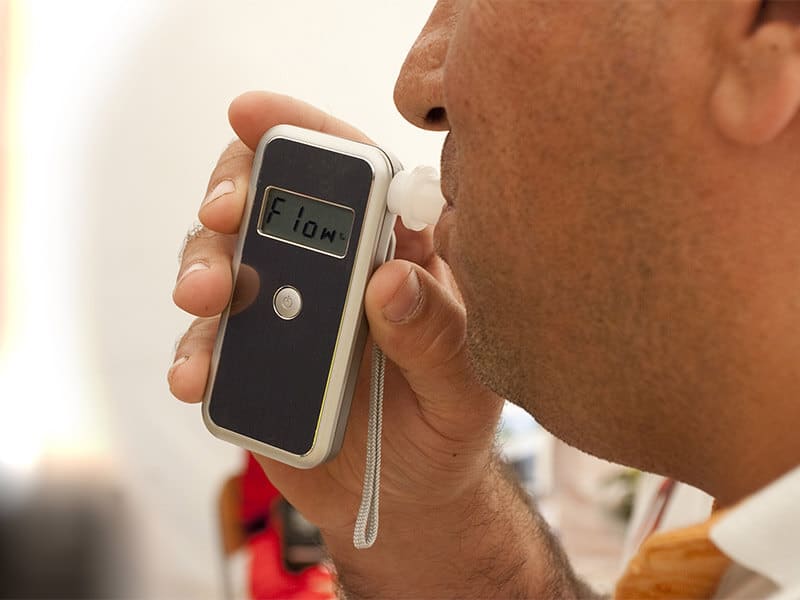Very much related to drug testing in the United States is alcohol testing. Alcohol testing is often performed for workplace drug testing programs and also for court ordered situations, probation cases, child custody cases, DUI or DWI cases, child protection agency cased, divorce cases in other situations that may arise where an alcohol test is necessary.
Alcohol testing can be pretty confusing as there are many types of alcohol testing and the testing can be done with different specimen types. Below I will discuss all of these options.
Breathalyzer

One of the most common types of alcohol testing is testing the breath with a Breathalyzer which is a device used for measuring the amount of alcohol in a driver’s breath. The measurement correlates to the measurement provided when a blood alcohol test is performed. This can tell us if the person being tested is currently impaired as the test provides an accurate determination of the quantity of alcohol reaching the brain.
We commonly call the person administering the breathalyzer a breath alcohol technician (BAT). The breathalyzer device used for workplace alcohol testing should be an approved device on a conforming products list maintained NHTSA – the National Highway Traffic Safety Administration. For companies regulated by the United States Department of Transportation (DOT), workplace alcohol testing is required and the use of an approved device is mandated; also, the BAT must have received documented training and qualification to administer the breath alcohol tests. Non regulated employers would be safe to follow the same procedures in the absence of any State law that states otherwise.
Currently, for DOT regulated companies, alcohol testing is authorized and required for reasonable suspicion testing, post-accident testing, return to duty testing, follow up testing and random testing. Alcohol testing in the DOT required drug/alcohol testing program is optional for pre-employment. Two of the DOT agencies prohibit alcohol testing for random testing. These include Pipeline & Hazardous Materials Safety Administration (PHMSA) and the United States Coast Guard (USCG).
Instant Saliva Alcohol Testing
Instant saliva alcohol testing is also allowed under DOT regulations but only for the initial screening test. Any alcohol test results from an instant saliva alcohol test that shows a level of 0.02 breath alcohol concentration (BAS) must have a second test administered fifteen minutes later using the approved breathalyzer device. These Alcohol Screening Devices (ASD) used in the DOT alcohol testing process for the initial screening test only must be on the NHTSA conforming products list of screening devices to measure alcohol in bodily fluids. Screening Test Technicians (STT) administrating these tests for DOT regulated alcohol testing must have documentation of training and qualification to administer these alcohol tests.
With a few exceptions, it is highly recommended to follow above procedures for all workplace alcohol testing. Two of the exceptions involve Florida and Minnesota. In Florida, those companies following the Florida Drug Free Workplace Program to receive workers comp discounts must by statute and rule perform alcohol testing with a blood draw and the blood sent to laboratory for blood alcohol testing – initial screening and confirmation testing if the result is 0.04 g/dL BAL or above. In all reality this seems like a quirk on the statute and rule written in 1993. The blood alcohol test is invasive; it is hard to find appropriate collectors to draw the blood and also very expensive. The difficulty in collecting the blood samples increases as kits for alcohol testing collections must have a 7ml blood vial that contains an anticoagulant and a preservative of sodium fluoride. The blood specimens are collected using an aseptic venipuncture technique.
Minnesota also has a unique workplace drug testing law that for non-DOT employer programs, all specimens collected for drug or alcohol testing must be sent to a laboratory for analysis. This would require blood alcohol testing as described above or new technology that allows labs to test for alcohol with oral fluid. One of the major laboratories, LabCorp, has lab based oral fluid testing that will detect ethyl alcohol.
Urine Alcohol Testing
This discussion on alcohol testing must include information regarding alcohol testing with urine. Laboratories can detect ethyl alcohol in urine specimens, but it is not at all recommended for workplace drug testing. Remember that alcohol is a legal drug and it is not illegal or a violation of any company policy to have a beer or a glass of wine on the weekend when you are off work. A few important points:
- A positive results for ethyl alcohol in a urine specimen will not prove current impairment.
- It is difficult to equate a urine test result for alcohol to a particular blood or breath alcohol level.
- Urine alcohol testing for ethyl alcohol is currently the least effective method in determining the amount of alcohol in the body.
- Individuals with a yeast infection, bacteria or potentially diabetes can have fermentation of sugars which can cause a positive urine alcohol drug test.
BAT (Breath Alcohol Test)
Lorem ipsum dolor sit amet, consectetur adipiscing elit. Ut elit tellus, luctus nec ullamcorper mattis, pulvinar dapibus leo.
BAT (Breath Alcohol Test) is highly recommended for workplace clients who wish to determine impairment or prohibited use of alcohol. In some circumstances, a blood alcohol test may be an acceptable testing method but may not be authorized in some programs (always check State Drug Testing Laws). Remember, a positive urine alcohol test is not indicative of alcohol impairment nor does it definitively indicate beverage alcohol consumption.
We do see some court ordered alcohol tests and probation tests requiring urine alcohol testing for ethyl alcohol. For the same reasons stated above we do not recommend this; however, the ordering authority (Probation Officer, Court Order or Judge) may insist on a test such as a 5 panel drug test to include ethyl alcohol.

EtG Testing
The last discussion on alcohol testing will focus on EtG testing with urine and EtG testing with hair. EtG is Ethyl glucuronide which can be detected in urine for up to 5 days after alcohol use. EtG is the metabolite of ethanol that is detectable after passing through the liver.
A positive finding of EtG in the urine of an individual provides strong evidence that the person recently consumed alcohol, even if the alcohol itself is no longer detectable. Therefore, this compound is regarded as a biomarker of alcohol consumption and can detect relapses of alcohol use by an individual who is under restriction. EtG should not be used for workplace testing, it might be used in follow up alcohol testing being monitored by a treatment professional. Individuals in a required EtG alcohol testing program need to be aware that this is a zero tolerance program for any consumption including mouthwash, breath spray, hand sanitizer and foods prepared with or flavored with alcohol.
One thing often asked is how long will EtG be detected in the urine. It is not an exact answer as many factors must be considered. One must consider how much alcohol an individual has consumed and what reporting limit for EtG is being used. Among persons who are not alcoholics participating in controlled drinking studies, ethanol has been detected in urine samples for up to 2 days after drinking approximately the equivalent of six 12 ounce glasses of beer. EtG has been measured in urine samples for up to 80 hours after heavy ethanol exposure.
EtG is the metabolite of ethanol after passing through the liver.
EtG can also be detected in hair testing. The window of detection will be different. It will take EtG about a week to arrive in the hair to be able to be detected. However the EtG can be detected for up to 90 days and can provide a behavioral indication of alcohol use.
We see folks ordering hair testing for EtG for alcohol treatment programs, court cases, DUI and DWI, child protective agency cases, divorce cases and sometimes for probation. Many laboratories do not provide EtG hair testing. National Drug Screening does work with several specialty laboratories in the United States that perform hair testing for EtG. Hair collection facilities are available in every city in the United States. We see a lot of hair EtG cases from Houston, Texas; all areas of New York City, and Atlanta, Georgia and surrounding areas.
Again, EtG testing is not at all recommended for workplace testing programs. The test is not measuring current impairment.
For workplace alcohol testing, employers should use caution and discuss with a professional the options that are available that are legal and will prevent liability. As a legal drug, alcohol testing must be handled differently from drug testing.






